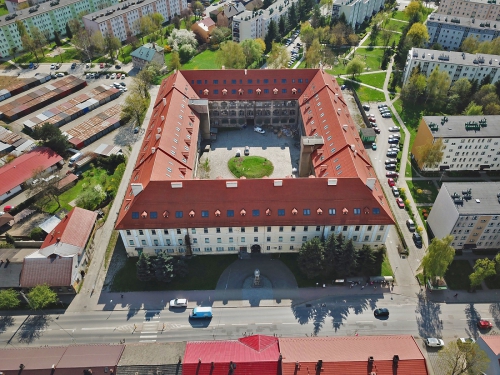Until the 1770s, the major transport routes bypassed Wadowice; hence, the town did not have any strategic or military importance. This situation changed fundamentally with the ‘arrival’ of the Austrians. As early as 1790, the Austrian command, fearing war with Prussia, decided to deploy troops along the road connecting Wadowice with Sucha in order to safeguard the traffic moving towards Hungary. But it was the routing of the highway connecting Vienna with Lviv that turned out to be decisive. It was then that Wadowice became an important point on this route. The military advantages of the town had already been noted at the turn of the 19th century. By 1820 a provisions ware house was built for the army in them western part of Wadowice in Wiedeńska (today Mickiewicza) Street. Soon after, the seat of administration of the district was moved to Wadowice (1819), the first military troops began to be redeployed to the town. These were reserve units of the 56th Infantry Regiment of Myślenice, which arrived in Wadowice in 1823.
Barracks of the Imperialand Royal 56th Infantry Regiment
In 1825 Wadowice was chosen to be the permanent base of the 56th Infantry Regiment (Kaiser und Koenig Infantiere Regiment). At present, the three-storey building (from 1827) is considered as one of the better preserved buildings of this type in Poland. The barracks were constructed on the ‘Imperial Highway’ (approx. 600 m from the town centre) so that the army could use the main transport route of Wadowice and Galicia whenever it was convenient. Until the mid-19th century, Wadowice remained the most important point on the military map in western Galicia. The local garrison not only fulfilled the functions of police and defence, as during the November Uprising, but was also a considerable force in suppressing the Cracow Uprising (1846). In the latter half of the 19th century, the military status of the town began to decrease, which followed from the change made by the army command in the tactics as well as the fortifying of the strongholds in Cracow and in Przemyśl. When Poland regained independence, the place of the 56th Austrian Regiment was taken over by the 12th Infantry Regiment, which from 1924 bore the title of the 12th Infantry Regiment of the Territory of Wadowice. The 56th Austrian Infantry Regiment could boast its own signature piece of music. The score Potpourri fur Militar Musik was composed by an infantry soldier and member of the regiment band, Josef Dawid.
Building of the ‘municipal barracks’ of the 54th National Defence Regiment
In the mid-19th century, the garrison was strengthened by the addition of cavalry troops. For this purpose, in 1854, the buildings situated opposite the main infantry barrack were appropriately adapted. The other barracks, together with the stable facilities at the back of the building, could house at least a cavalry squadron. In order to satisfy the needs of the army, huge swathes of land stretching towards the River Skawa (eastwards) and towards the Łozówka field (northwestwards, as far as Młyńska (currently Legionów) Street, were taken over. In the cavalry barracks, referred to as the ‘municipal barracks’, the 54th National Defence Regiment (Landwehr) was stationed. Then, in 1901, it was moved to Cieszyn where it was incorporated into the 31st National Defence Regiment. In the first few years of the 20th century, the land occupied until then by the cavalry troops, the National Defence Regiment and the artillery was converted into the industrial district of Wadowice, which still exists today. In 1871 command over the local Landwehr (National Defence) Regiment was taken over by Józef Baum’s elder brother, Antoni Baum (1819-1888). He took part in one of the biggest battles of the 19th century, the Battle of Königgrätz (1866), which was the decisive battle of the Austro-Prussian War.

